27 Diving Deeper into Endangered Languages
Ananya Talwar
Click to listen to this essay
In this piece Talwar aims to educate audiences about endangered languages and what we can do to prevent their extinction. Initially in the form of a blogpost, Talwar presents research findings in a series of infographics. Talwar highlights the versatility of infographics by making them applicable to social media (such as Instagram and Snapchat). The author uses the similar graphics on social media “stories” to publicize the blogpost itself. In this way, Talwar engages in multiple mediums with multiple audiences to circulate the conversation and create greater awareness about endangered languages. The content content below was originally shared on a personal website, hosted by Talwar (which is now disconnected). In addition to figure captions, we also provide the alt-text (alternative text) coded with each image to demonstrate how images should be prepared for screen readers.
Ananya Talwar
Instructor
ENGLWRIT 112: College Writing
Day Month Year
Diving Deeper into Endangered Languages
Blogpost Text
Endangering languages is a distressing and alarming issue. UNESCO (United Nations Educational, Scientific and Cultural Organisation) states that a language becomes extinct when nobody speaks or remembers the language and that the loss of languages can have cultural, social, developmental, communal, religious and political repercussions. Languages define our cultural identities, social behaviors, communication styles, technical vocabulary, and our way of thinking. Loss of language can have imploding repercussions on human society, and thus this issue must be addressed at the earliest to save dying tongues. Read below to gain more perspective.
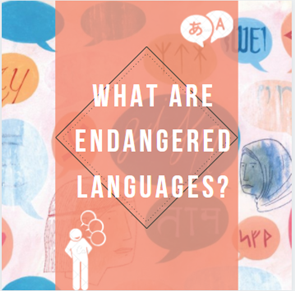
Alt-text: Background image of blue, orange, brown, and pink dialogue bubbles of various sizes and shapes. The dialogue bubbles include writing systems from various languages. Central image is of a salmon pink rectangle. It reads: “What are endangered languages?” in white text. To the upper right corner of the rectangle are two dialogue bubbles: one is of Japanese Hiragana; the other is of the Latin alphabet. To the bottom left corner of the rectangle is a white body speaking with three dialogue bubbles to the right of the body’s mouth.
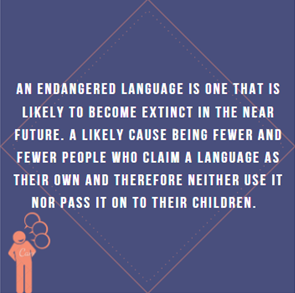
Alt-text: Purple background. White text at center of the graphic reads: “An endangered language is one that is likely to become extinct in the near future. A likely cause being fewer and fewer people who claim a language as their own and therefore neither use it nor pass it on to their children.” At the bottom of the image is a salmon pink body speaking with three dialogue bubbles to the right of the body’s mouth.
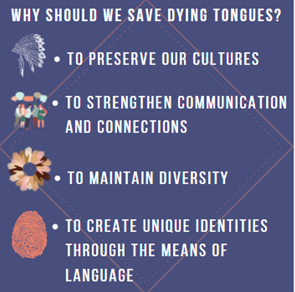
Alt-text:
Purple background. White text of the graphic reads “Why should we save dying tongues?” followed by white bullet point text:
To preserve our cultures; image to the left of bullet point is a white Indigenous headdress
To strengthen communication and connections; image to the left of the bullet point is a group of people talking to each other indicated by blue, pink, and gray dialogue bubbles above their heads
To maintain diversity; image to the left of the bullet point is a cluster of brown, tan, and white hands raised to form a circle
To create unique identities through the means of language; image to the left of the bullet point is a salmon pink fingerprint
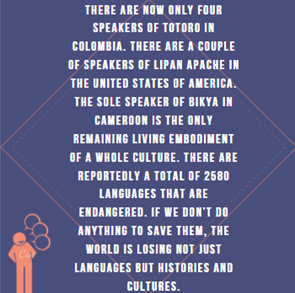
Alt-text: Purple background. White text at center of the graphic reads: “There are not only four speakers of Totoro in Colombia. There are a couple of speakers of Lipan Apache in the United States of America. The sole speaker of Bikya in Cameroon is the only remaining living embodiment of a whole culture. There are reportedly a total of 2580 languages that are endangered. If we don’t do anything to save them, the world is losing not just languages but histories and cultures.” At the bottom of the image is a salmon pink body speaking with three dialogue bubbles to the right of the body’s mouth.
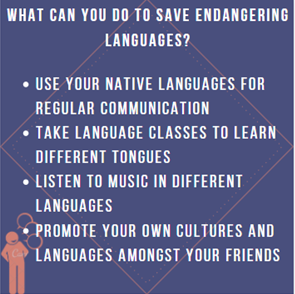
Alt-text:
Purple background. White text of the graphic reads “What can you do to save endangering languages?” followed by white bullet point text:
Use your native languages for regular communication
Take language classes to learn different tongues
Listen to music in different languages
Promote your own cultures and languages amongst your friends
At the bottom of the image is a salmon pink body speaking with three dialogue bubbles to the right of the body’s mouth.
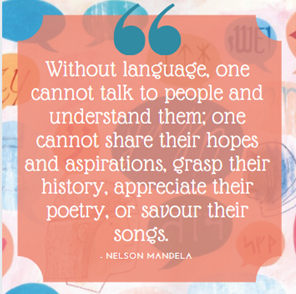
Alt-text: Background image of blue, orange, brown, and pink dialogue bubbles of various sizes and shapes. The dialogue bubbles include writing systems from various languages. Central image is of a salmon pink square. It is a quote from Nelson Mandela that reads: “Without language, one cannot talk to people and understand them; one cannot share their hopes and aspirations, grasp their history, appreciate their poetry, or savour their songs.” A teal open quotation appears at the top of the square.
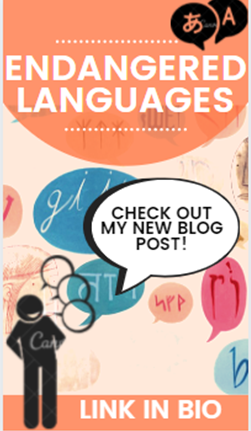
Alt-text:
This is part of an Instagram story. Background image of blue, orange, brown, and pink dialogue bubbles of various sizes and shapes. The dialogue bubbles include writing systems from various languages. At the top of the image is a semi-circle with “Endangered Languages” in white text. To the upper right corner of the rectangle are two dialogue bubbles in black: one is of Japanese Hiragana; the other is of the Latin alphabet. At the center of the image is a white text bubble that reads: “Check out my new blog post!” in black text. To the bottom left corner of the rectangle is a black body speaking with three dialogue bubbles to the right of the body’s mouth. At the bottom of the image is a salmon pink line that reads “Link in bio” white text.
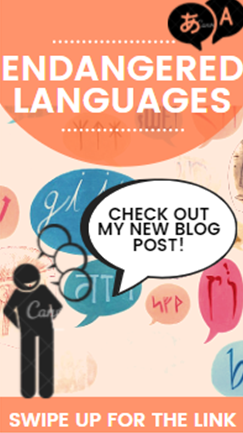
Alt-text:
This is part of a Snapchat story. Background image of blue, orange, brown, and pink dialogue bubbles of various sizes and shapes. The dialogue bubbles include writing systems from various languages. At the top of the image is a semi-circle with “Endangered Languages” in white text. To the upper right corner of the rectangle are two dialogue bubbles in black: one is of Japanese Hiragana; the other is of the Latin alphabet. At the center of the image is a white text bubble that reads: “Check out my new blog post!” in black text. To the bottom left corner of the rectangle is a black body speaking with three dialogue bubbles to the right of the body’s mouth. At the bottom of the image is a salmon pink line that reads “Swipe up for the link” white text.
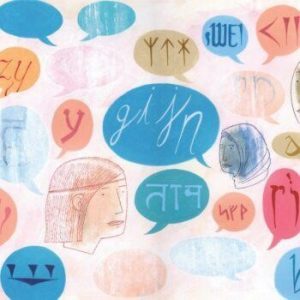
Alt-text: blue, orange, brown, and pink dialogue bubbles in different languages in various sizes and shapes
Works Cited
Ever Widening Circles. How Saving Languages Can Save the World! everwideningcircles.com. https://everwideningcircles.com/2019/03/27/saving-endangered-languages/
Strochlic, Nina. The Race to Save the World’s Disappearing Languages. National Geographic.com. https://news.nationalgeographic.com/2018/04/saving-dying-disappearing-languages-wikitongues-culture/

